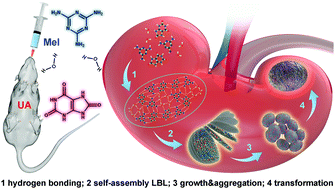Rate-controlled nano-layered assembly mechanism of melamine-induced melamine–uric acid stones and its inhibition and elimination methods†
Abstract
The outbreak of infant milk powder poisoning in China attracted worldwide attention. The investigations found that the real culprit of this incident was melamine (Mel), which induced the formation of kidney stones. However, little is known about the formation mechanism of infant stones, not to mention the preventive and therapeutic drugs. Here, through thermodynamic and kinetic tests, simulation in vitro and animal experiments, and multidisciplinary analysis and verification, we found that the formation of this kidney stone is a rate-controlled nano-scale supramolecular layered assembly process: Mel, uric acid (UA) and a small amount of H2O combine through hydrogen bonds to form a planar network supramolecular structure; the planar structures self-assemble layer-by-layer to form ellipsoidal nanocrystals through π–π stacking interactions, van der Waals force, hydrophilic/hydrophobic interaction, etc.; the small nanocrystals gradually grow and aggregate concentrically to form ellipsoidal Mel–UA stones under the control of the matrix. Based on the above process, we screen out an effective inhibitor and eliminator for stones, potassium citrate (K3Cit), which works through both hydrogen bonding and alkalinity. This work solves the most challenging conundrum left by the Mel incident and blazes a trail for the prevention and treatment of kidney stone disease.



 Please wait while we load your content...
Please wait while we load your content...